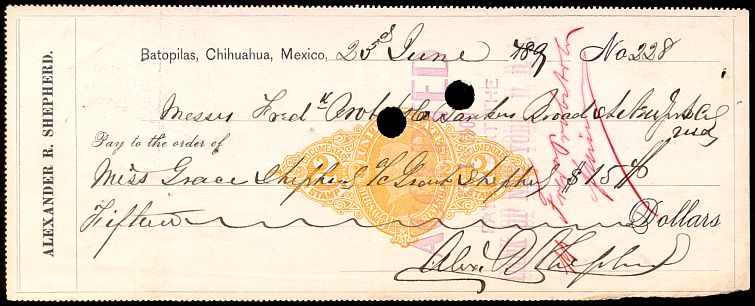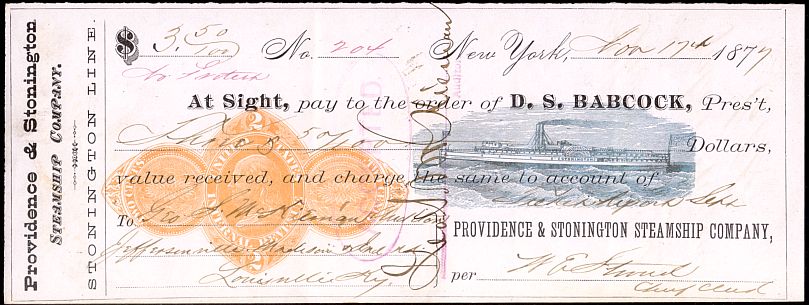by Coleman Leifer
The check illustrated, which has an RNX-7 imprinted revenue, is unusual in that it was issued in Mexico. The maker of the check was Alexander Robey Shepherd, a former territorial governor of the District of Columbia (Washington, D.C.). The payee is “Grace Shepherd a/c Grant Shepherd.” Grant Shepherd was one of Alexander’s sons and was named after President Grant. Grace was Grant’s daughter.

Shepherd was born in Washington In 1835. He withdrew from school upon his father’s death and held jobs as a store boy, a carpenter’s apprentice and a plumber’s assistant. He eventually opened his own plumbing business and engaged in real estate and building. He was a Republican and a Union supporter and served as a three-month volunteer to the Civil War. He then began a career in municipal politics including service as president of the District of Columbia common council.
At the time the infrastructure of Washington was in miserable shape. An article in the October 9, 1887 issue of the Washington Chronicle, which accompanied the illustration of Shepherd shown with this article, described the city at the time: “For years Washington had lain neglected and forlorn, its streets muddy and dusty by turns, its architecture rude and primitive. Squalid shanties occupied the public reservations, the city was a disgrace to the country, the malaria breeding flats lay festering in the sun. Progress seemed to have closed her eyes and passed the city by.
Shepherd became an advocate of modernizing the city in an effort to thwart a proposal to move the Capital to another location. His efforts were successful when Congress, in 1871, created a territorial government for the District of Columbia including a Board of Public Works. President Grant named him to the board and he quickly assumed charge of things, earning the name “Boss Shepherd.” In 1873 Grant named him territorial Governor. In his enthusiasm to improve the city he spent millions of dollars beyond the amount authorized.
He transformed Washington into a city with paved streets, sidewalks, adequate water and sewage facilities, gas lights and parks. His method of getting things done by awarding contracts, often to his friends, and without competitive bidding, led to congressional investigations and, in 1874, to replacement of the territorial government by commission rule. President Grant promptly named him one of the commissioners but the Senate refused to confirm him although he had been cleared of personal dishonesty.
Shepherd built a mansion near Washington’s Dupont Circle, but during his period of public service had not paid adequate attention to his personal finances. At the time he was forced from office he was reputedly one million dollars in debt. But he obtained permission from the Mexican government to develop a silver mine at Batopilas, Chihuahua, Mexico and managed to recoup his fortune. In 1887 he resumed to Washington to recover from a head injury suffered at his mine and was hailed as a public benefactor. A parade in his honor drew 100,000 people and there were 20,000 people near the reviewing stand when he gave a speech expressing his gratitude to the city.
When he died, in Batopilas in 1902, as the aftermath of an appendicitis attack, he was given
a hero’s funeral in Washington. The cortege was the largest ever seen in the city up to that time. In 1909 a statue of Governor Shepherd was erected at Fourteenth Street and Pennsylvania Avenue in front of the District Building (the city hall.)
The statue was placed in storage several years ago as a result of construction in the area. At the present time it is in an automobile impoundment lot across an interstate highway from the city’s sewage treatment plant. This is surely an unfortunate location for the statue of a man who was responsible for the post-Civil War modernization of the Nation’s Capital. However, an effort is currently being made to place the statue in a small park near the building that served as the Washington city hall during Shepherd’s time and near the site of the Department of Public Works building where Shepherd had his office. (It is back in a place along Pennsylvania Avenue as of 2018 – Editor.)
Source: Dictionary of American Biography; Charles Scribner’s Sons, New York, 1935.
Thanks also to Dr. P. W. Ogilvie, District of Columbia Office of Public Records.
The original article ran in the January – March 1997 issue of The Check Collector.
